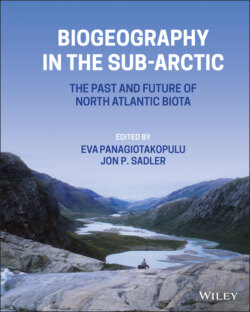Читать книгу Biogeography in the Sub-Arctic - Группа авторов - Страница 24
Seaward Dipping Reflectors
ОглавлениеIn the Kangerdlugssuaq region of East Greenland transition from flat‐lying lavas into a zone in which the lavas acquire increasingly steep dips towards the coast was first recorded by Wager (1934, 1947) and described by Larsen and Jakobsdottir (1988) (Figure 10, see Plate section). The zone of down‐warping is accompanied by an increase in the intensity of the coast‐parallel dyke swarm, culminating in an underlying ‘sheeted complex’ comparable to those seen in ophiolite occurrences regarded as uplift portions of oceanic crust (Nielsen and Brooks 1981; Muttervet al. 1982; Brooks 2011). It came to be realized that what marine seismologic surveyors referred to as ‘seaward‐dipping reflectors’, occurring as belts up to 150 km wide, occur on both sides of the Atlantic and also in west Greenland, were the off‐shore equivalents of these down‐warped lavas.
Figure 10 Kap Hammer on the East Greenland coast (67°40′N), within the zone showing maximum seaward flexing. The cliffs here consist almost entirely of dykes, thus composing a ‘sheeted complex’. Since the flexure here is eastwards, the dykes have a corresponding westward dip. The greater the inclination, the older the dyke. A few (young) near‐vertical dykes are seen in the near cliffs.
Source: Photo by B.G.J. Upton.
The lavas acquired their seaward dips long after the time of their eruption, which had been sub‐aerial (Brooks 2011). Since the total thickness of lavas and their associated intrusions on the rifted margins reaches 25–35 km (Reid et al. 1997; Smallwood and White 2002), these great quantities of basaltic materials on the thinned continental lithosphere would have very significantly increased its bulk density causing the down‐warping. Figure 11 (see Plate section) shows subaerial exposures in West Greenland analogous to those of East Greenland where initially sub‐horizontal lavas were down‐warped towards a new ocean floor in Baffin Bay. As demonstrated in East Greenland, the down‐warping was achieved, not by ductile folding but by displacements along a myriad normal faults dipping away from the developing ocean (Nielsen 1975; Nielsen and Brooks 1981).
